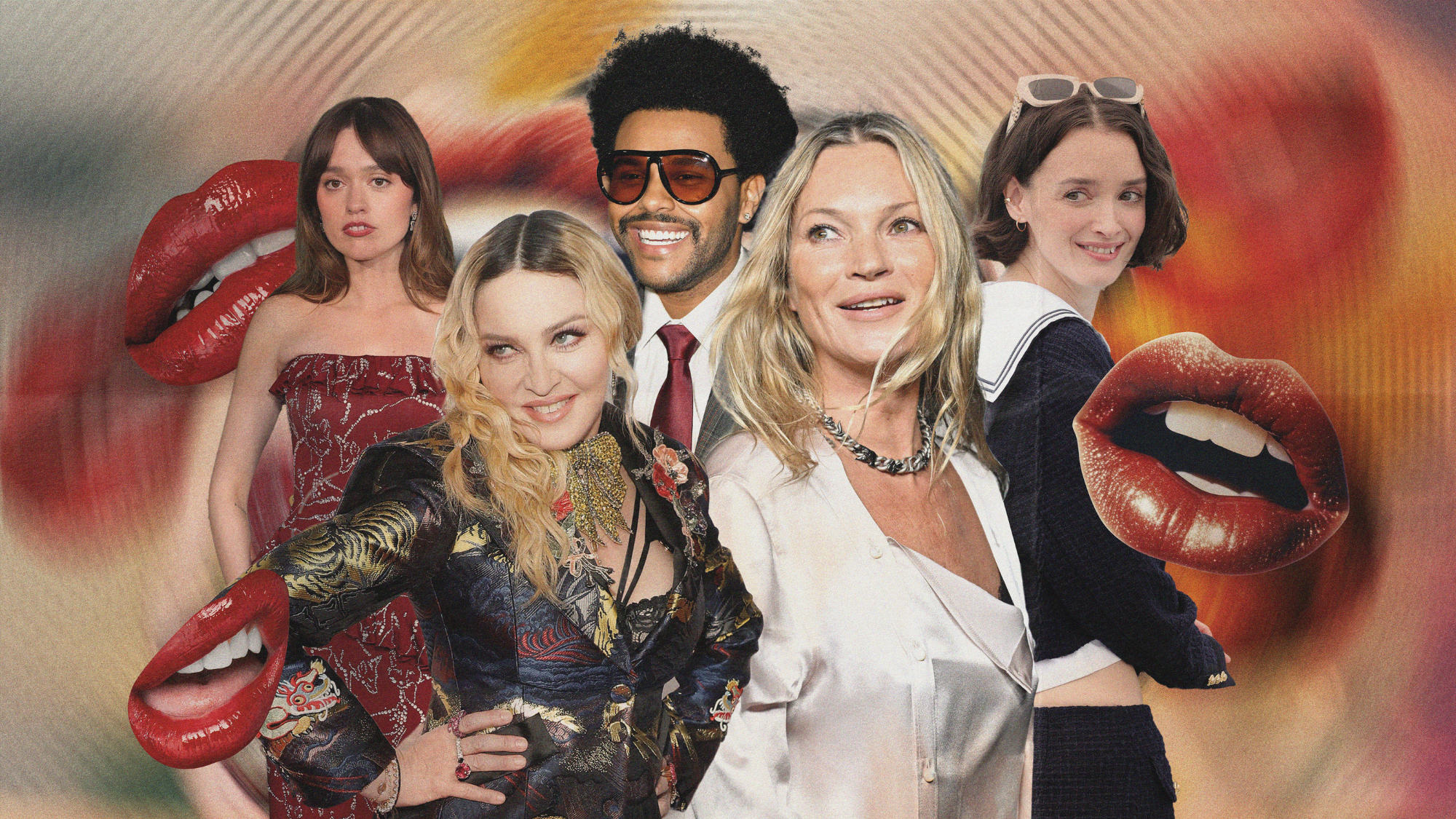Aimee Lou Wood’s smile proves Hollywood has fallen out of love with veneers—could natural teeth be the next status symbol?
A new dawn for our chompers


Spotting veneers has become a sport in my household. Specifically, when it comes to the actors, singers and reality stars who have swapped their previously inconspicuous gnashers for a supersized look, often of the blinding white, gum shield-esque variety. While the quality of work varies, it’s hard to pick out a celebrity, from The Weeknd and Margot Robbie to Michael B. Jordan and Scarlett Johansson, that doesn’t have a set. Perhaps this explains all the conversation around The White Lotus’s Aimee Lou Wood, whose gappy, bucked and incredibly charming chompers have wooed the internet.
In a recent interview with Jonathan Ross, Wood says she “can’t believe the impact” her smile has had. “It feels so lovely, a real full-circle moment after being bullied for my teeth forever… Now people are clapping in an audience.” Just a few years prior, this wouldn’t have been a topic of conversation, but now, it’s hailing the return of “natural teeth”. Could it be true that we haven’t seen a set of real, characterful teeth in so long?
First created to enhance the smiles of golden age Hollywood actors, including Judy Garland and Shirley Temple, veneers have been around for over a century. Mainstream uptick was slow before a boom in the 80s and 90s, when cosmetic dentists became differentiated from general practitioners. Today, they have never been more popular or ubiquitous. Once reserved for A-listers, the uber-elite, or damaged teeth, veneers have become a status symbol, but unlike a Van Cleef necklace or a 24-hour chauffeur on your doorstep, this can’t often be undone, especially if it’s cheap.

The most expensive, long-lasting and natural-looking are porcelain veneers. These start at around £600 per tooth, but can go as high as £1350 at high-end clinic LUCEO, founded by Dr. Tom Crawford-Clarke. Composite veneers are more popular, and cost between £300 and £525 per tooth, but it is machine-made veneers that have substantially lowered the price of the procedure, by around 50 to 70 per cent, and democratised the look. It is these that often get the “Turkey teeth” label, as they are more likely to compromise on shape and fit. The worst of them result in an uncanny valley of a mouthful, where teeth are all the same size and resemble a white picket fence or erect tombstones.
Once reserved for A-listers, the uber-elite, or damaged teeth, veneers have become a status symbol, but unlike a Van Cleef necklace or a 24-hour chauffeur on your doorstep, this can’t often be undone, especially if it’s cheap.
Despite providing less invasive cosmetic services like Invisalign, Dr. Crawford-Clarke tells me that the demand for veneers has increased year on year, to the point where nearly everyone who visits his clinic asks for them. “It’s led to the artificial cookie-cutter appearance that we call ‘Instagram Face,’” he states. “I have had patients coming to see me for corrective work as they regret how it looks. They weren’t smiling, weren’t going out socially and were depressed by their appearance.”
It’s not just me, dissecting A-list teeth has been a sport on social media for some time. Speaking to his 136K Instagram followers, Dr Jordan Davis praises, but more often laments, the dental work done by the world’s biggest stars. He still fits veneers, but is part of a growing movement of dentists who are showing that it doesn’t need to look this way.
A post shared by Dr. Jordan Davis | Cosmetic Dentist (@drjordandavis_)
A photo posted by on
“Many people have come to think that getting veneers means you automatically end up with the chiclets, and that couldn’t be further from the truth,” asserts LA-based dentist, Dr. Jon Marashi, whose celebrity clientele includes Lindsay Lohan, Joaquin Phoenix, Halsey and Cher. “Veneers can be sculpted to almost any form, but it requires a tremendous amount of artistic skill to pull it off, so they are undetectable.”
Celebrity news, beauty, fashion advice, and fascinating features, delivered straight to your inbox!
For his part, Dr. Crawford-Clarke explains that veneers don’t necessarily mean you need to irreversibly file down your natural teeth into unnerving-looking pegs. At his minimally invasive practice, they aim to remove less than 0.7mm of a tooth when providing porcelain veneers, and where possible, nothing at all. This, of course, costs money. Lots of money.
Still, not long ago, natural, “imperfect” teeth were status symbols in their own right; a badge of authenticity, or even rebellion, within a picture-perfect Hollywood system. Barbara Streisand famously refused to get a nose job for fear of ruining her voice. And then there are actors like Woody Harrelson, Eddie Murphy, Tom Hardy, Willem Dafoe, and Steve Buscemi, whose interesting teeth have become an irrevocable part of their look.

Some of the most influential women in the world also have distinctive gnashers, which I would say have played a role in their iconic status. Madonna has referred to her smile as “ugly” but has never had the gap between her two front teeth closed. Kirsten Dunst has spoken proudly about her “snaggle fangs”, and Kate Moss’s “gangly” teeth paved the way for gap-toothed beauties in high-fashion editorials, like Georgia May Jagger and Lara Stone.
Can distinctive teeth make celebrities more memorable? “Quite so,” replies Professor Nicholas Rule, who studies the psychology of faces and is the dean of the University of Toronto Mississauga. Perhaps, this is why we can’t get enough of Aimee Lou Wood, and for that matter, her co-star, the French-Canadian model, Charlotte Le Bon, who boasts a set of fanged teeth that criss-cross over each other in a similarly endearing manner. In a world where there are concerns about actors’ ability to emote amidst the proliferation of filler and botox, surely embracing natural smiles is a step in the right direction.
When I was researching this piece, the overwhelming majority of people I spoke to were partial to “imperfect” teeth. Tom*, a 20-something creative, told me that “a little gap or crook is endearing and cute”. Jenny*, 38, added, “I find crooked teeth so sexy! Perfection is boring.” Elsbeth, 29, who works in fashion PR and has a beautiful gap between her two middle teeth, added: “I went to school in Essex and people always had something to say. My dad didn’t want to splash on braces, and I’m so glad because now they are my signature, and I wouldn’t trade them for the world. But I had a period where men would hyper-sexualise my teeth. The conclusion is: they are polarising.”

How your teeth are perceived is highly circumstantial. Many in public-facing jobs, or who live in more image-conscious areas, like Essex, still favour the quintessential veneer look. Gina*, a 40-year-old ex-pro dancer, says she would have a full set of veneers if she could afford it. “Being surrounded by good-looking people most of my career, I suppose my view is slightly skewed, but I just think it looks gorgeous. I smile and laugh all the time, so I’d love them on myself.”
In a world where there are concerns about actors’ ability to emote amidst the proliferation of filler and botox, surely embracing natural smiles is a step in the right direction.
She is not wrong. Dr Rule points out that even today, in 2025, veneers are generally proven to increase facial attractiveness, and the benefits of this are substantial. “Research has consistently shown that people who look more attractive are considered to be better at everything: smarter, stronger, richer. This premium leads them to benefit in terms of making more money, living longer, and achieving greater success.” This “attractiveness halo” extends to people who have undertaken cosmetic enhancements. “We found that, although people could tell they had gotten surgery, and thought negatively of them for doing so (for example, that they were shallow and vain), nevertheless favored them as the procedures ultimately made them look more attractive.”
But if we hit peak veneer in 2024, the pendulum seems to be swinging back in favour of more natural-looking chompers. This can be chalked up to a greater awareness of “bad” work, sure, but also an increased understanding of the importance of a healthy mouth. Gum disease—which can be caused or exacerbated by badly fitted veneers—isn’t just linked with bad breath, but also serious health conditions like heart disease and Alzheimer’s.
“Patients are now more interested in achieving healthy, pink gums and natural tooth colour and contour than an overly engineered look,” explains Dr. Reena Wadia, the founder and principal gum specialist at RW Perio. “They are starting to understand that addressing the foundations first, healthy gums and bone structure, is essential before considering cosmetic improvements.” Her clinic offers a "gum lift" to reshape the gum and bone tissues, as well as "gum veneers", which create a natural and aesthetically pleasing smile, all while supporting periodontal health. They are now her two most popular treatments.
Teeth have been trendy for quite some time, and in a world ruled by aesthetics, things can change fast. Perhaps it’s the basics we should take heed of: feeling confident and happy in our smiles—and ensuring they are healthy, no matter how they look. Or as a friend put it to me recently: “I don’t mind a gap tooth or anything… As long as their breath stays fresh.”
*Some names have been changed

Nessa Humayun is the Beauty Editor at Marie Claire UK. With over eight years of editorial experience across lifestyle sectors, Nessa was previously the Editorial Lead of HUNGER Magazine, and has bylines in British Vogue, Dazed, and Cosmopolitan. A self-confessed human guinea pig, Nessa covers everything from product must-haves to long-reads about the industry writ large. Her beauty ethos is all about using products that work hard, so you don't have to.